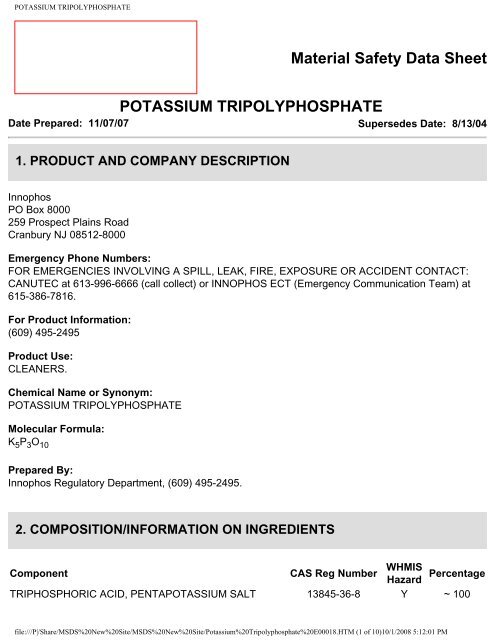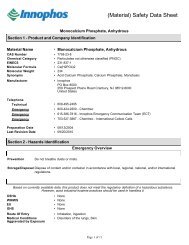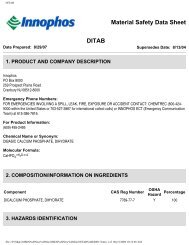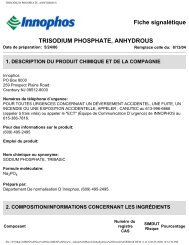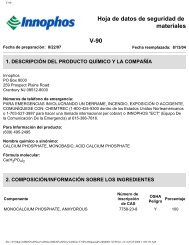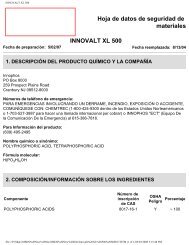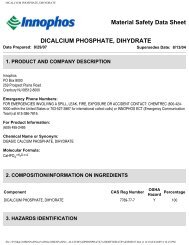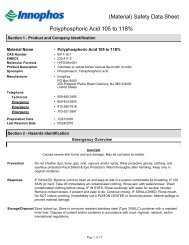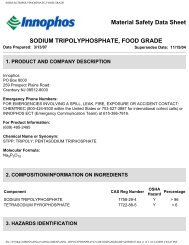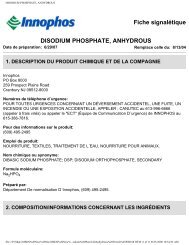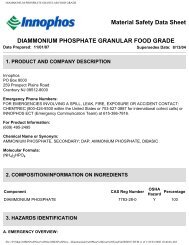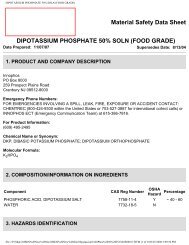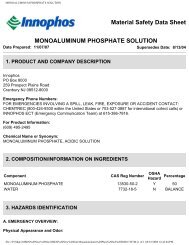POTASSIUM TRIPOLYPHOSPHATE - Innophos
POTASSIUM TRIPOLYPHOSPHATE - Innophos
POTASSIUM TRIPOLYPHOSPHATE - Innophos
You also want an ePaper? Increase the reach of your titles
YUMPU automatically turns print PDFs into web optimized ePapers that Google loves.
<strong>POTASSIUM</strong> <strong>TRIPOLYPHOSPHATE</strong>Not ApplicableExtinguishing Media:Not combustible. Use extinguishing method suitable for surrounding fire.Special Fire Fighting Procedures:Firefighters should wear NIOSH/MSHA approved self-contained breathing apparatus and full protectiveclothing. Dike area to prevent runoff and contamination of water sources. Dispose of fire control waterlater.Unusual Fire and Explosion Hazards:Not combustible.Hazardous Decomposition Materials (Under Fire Conditions):oxides of phosphorus6. ACCIDENTAL RELEASE MEASURESEvacuation Procedures and Safety:Wear appropriate protective gear for the situation. See Personal Protection information in Section 8.Containment of Spill:Follow procedure described below under Cleanup and Disposal of Spill.Cleanup and Disposal of Spill:Sweep or vacuum up and place in an appropriate closed container (see Section 7: Handling andStorage). Avoid creation of dusty conditions. Clean up residual material by washing area with waterand detergent. Collect washings for disposal. Decontaminate tools and equipment following cleanup.Environmental and Regulatory Reporting:Prevent material from entering public sewer system or any waterways.7. HANDLING AND STORAGEMinimum/Maximum Storage Temperatures:Not AvailableHandling:Avoid direct or prolonged contact with skin and eyes. Avoid breathing dusts. Do not ingest.Storage:Store in tightly closed containers. Store in an area that is cool, dry, This product is hygroscopic andfile:///P|/Share/MSDS%20New%20Site/MSDS%20New%20Site/Potassium%20Tripolyphosphate%20E00018.HTM (4 of 10)10/1/2008 5:12:01 PM
<strong>POTASSIUM</strong> <strong>TRIPOLYPHOSPHATE</strong>tends to cake on storage.8. EXPOSURE CONTROLS/PERSONAL PROTECTIONIntroductory Remarks:These recommendations provide general guidance for handling this product. Because specific workenvironments and material handling practices vary, safety procedures should be developed for eachintended application. While developing safe handling procedures, do not overlook the need to cleanequipment and piping systems for maintenance and repairs. Waste resulting from these proceduresshould be handled in accordance with Section 13: Disposal Considerations.Assistance with selection, use and maintenance of worker protection equipment is generally availablefrom equipment manufacturers.Exposure Guidelines:No exposure limits were found for this product or any of its ingredients.Engineering Controls:Where engineering controls are indicated by use conditions or a potential for excessive exposureexists, the following traditional exposure control techniques may be used to effectively minimizeemployee exposures: general area dilution/exhaust ventilation.Respiratory Protection:When respirators are required, select NIOSH/MSHA approved equipment based on actual or potentialairborne concentrations and in accordance with the appropriate regulatory standards and/or industrialrecommendations.Under normal conditions, in the absence of other airborne contaminants, the following devices shouldprovide protection from this material up to the conditions specified by the appropriate OSHA, WHMISor ANSI standard(s): dust/mist filtering respirator.Eye/Face Protection:Eye and face protection requirements will vary dependent upon work environment conditions andmaterial handling practices. Appropriate ANSI Z87 approved equipment should be selected for theparticular use intended for this material.It is generally regarded as good practice to wear a minimum of safety glasses with side shields whenworking in industrial environments.Skin Protection:Skin contact should be minimized through use of gloves and suitable long-sleeved clothing (i.e., shirtsand pants). Consideration must be given both to durability as well as permeation resistance.Work Practice Controls:Personal hygiene is an important work practice exposure control measure and the following generalfile:///P|/Share/MSDS%20New%20Site/MSDS%20New%20Site/Potassium%20Tripolyphosphate%20E00018.HTM (5 of 10)10/1/2008 5:12:01 PM
<strong>POTASSIUM</strong> <strong>TRIPOLYPHOSPHATE</strong>measures should be taken when working with or handling this material:(1) Do not use, and/or consume foods, beverages, tobacco products, or cosmetics in areaswhere this material is stored.(2) Wash hands and face carefully before eating, drinking, using tobacco, applying cosmetics,or using the toilet.(3) Wash exposed skin promptly to remove accidental splashes or contact with this material.9. PHYSICAL AND CHEMICAL PROPERTIESPhysical and Chemical properties here represent typical properties of this product. Contact thebusiness area using the Product Information phone number in Section 1 for its exact specifications.Physical Appearance:white powder solid.Odor:odorless.pH:9 to 10.1 at 1 wt/wt%.Specific Gravity:1.16 at 15 C (59 F).Density:1.16 g/ml at 15 C (59 F).Water Solubility:soluble 19.3 wt/wt% at 25 C (77 F).Melting Point Range:620 to 640 C (1148 to 1184 FBoiling Point Range:> 1500 C (2732 F) at mmHgVapor Pressure:Not AvailableVapor Density:Not AvailableMolecular Weight:453.5file:///P|/Share/MSDS%20New%20Site/MSDS%20New%20Site/Potassium%20Tripolyphosphate%20E00018.HTM (6 of 10)10/1/2008 5:12:01 PM
<strong>POTASSIUM</strong> <strong>TRIPOLYPHOSPHATE</strong>10. STABILITY AND REACTIVITYChemical Stability:This material is stable under normal handling and storage conditions described in Section 7.Conditions To Be Avoided:dusting conditionsextreme heatextreme humidityMaterials/Chemicals To Be Avoided:none knownThe Following Hazardous Decomposition Products Might Be Expected:Decomposition Type: thermalnone knownHazardous Polymerization Will Not Occur.Avoid The Following To Inhibit Hazardous Polymerization:not applicable11. TOXICOLOGICAL INFORMATIONAcute Eye Irritation:Toxicological Information and Interpretation:eye - eye irritation, human. This material is expected to cause significant irritation to the eyes.Acute Skin Irritation:Toxicological Information and Interpretation:skin - skin irritation, rabbit. This material is expected to cause significant irritation to the skin.Acute Dermal Toxicity:No test data found for product.Acute Respiratory Irritation:No test data found for product.Acute Inhalation Toxicity:No test data found for product.file:///P|/Share/MSDS%20New%20Site/MSDS%20New%20Site/Potassium%20Tripolyphosphate%20E00018.HTM (7 of 10)10/1/2008 5:12:01 PM
<strong>POTASSIUM</strong> <strong>TRIPOLYPHOSPHATE</strong>Acute Oral Toxicity:No test data found for product.Chronic Toxicity:This product does not contain any substances that are considered by OSHA, NTP, IARC or ACGIH tobe "probable" or "suspected" human carcinogens.No additional test data found for product.12. ECOLOGICAL INFORMATIONEcotoxicological Information:Ecotoxological Information and Interpretation:LC50 - lethal concentration 50% of test species, 100 mg/l/96 hr, Mysidopsis bahia (saltwater mysid).EC50 - effective concentration 50% of test species, 100 mg/l/48 hr, Daphnia.Chemical Fate Information:No specific biodegradation test data located. While the alkalinity of this material is readily reduced innatural waters, the resulting phosphate may persist indefinitely or incorporate into biological systems.13. DISPOSAL CONSIDERATIONSWaste Disposal Method:Waste Management options should first consider possible re-use or recycling opportunities. Someprovinces have active "Waste Exchange" networks for re-use and recycling of wastes. Contact yourlocal waste management companies to explore available options. All waste management activitiesmust obey local, provincial and federal regulations. Possible disposal methods include the following:Container Handling and Disposal:Consult state and local regulations regarding the proper disposal of container.14. TRANSPORTATION INFORMATIONTransportation Status: IMPORTANT! Statements below provide additional data on listed DOTclassification.The listed Transportation Classification does not address regulatory variations due to changes inpackage size, mode of shipment or other regulatory descriptors.TDG Status:file:///P|/Share/MSDS%20New%20Site/MSDS%20New%20Site/Potassium%20Tripolyphosphate%20E00018.HTM (8 of 10)10/1/2008 5:12:01 PM
<strong>POTASSIUM</strong> <strong>TRIPOLYPHOSPHATE</strong>2 Health Hazard Rating--Moderate0 Flammability Rating--Minimal0 Reactivity Rating--MinimalReason for Revisions:Change and/or addition made to Section 4, Section 15.Key Legend Information:ACGIH - American Conference of Governmental Industrial HygienistsOSHA - Occupational Safety and Health AdministrationTLV - Threshold Limit ValuePEL - Permissable Exposure LimitTWA - Time Weighted AverageSTEL - Short Term Exposure LimitNTP - National Toxicology ProgramIARC - International Agency for Research on CancerND - Not determinedRPI - INNOPHOS Established Exposure LimitsDisclaimer:The information herein is given in good faith but no warranty, expressed or implied, is made.** End of MSDS Document **file:///P|/Share/MSDS%20New%20Site/MSDS%20New%20Site/Potassium%20Tripolyphosphate%20E00018.HTM (10 of 10)10/1/2008 5:12:01 PM


